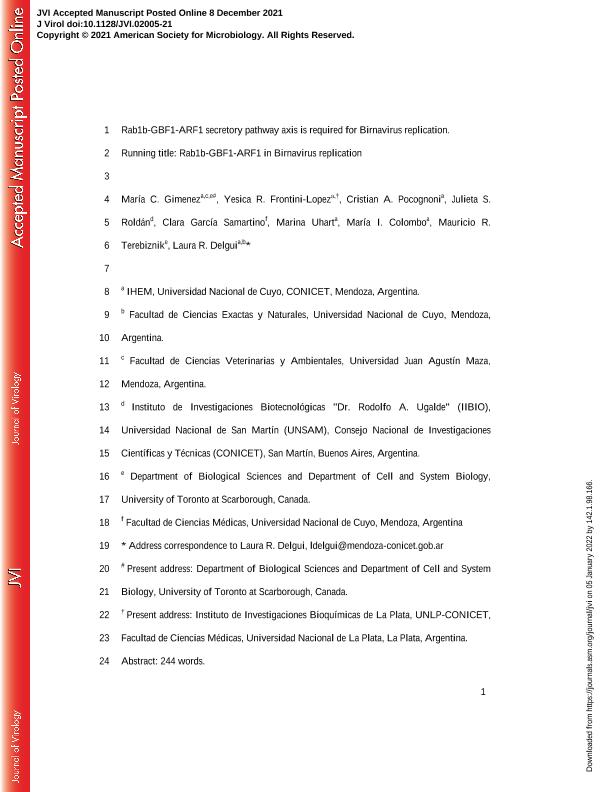Artículo
Rab1b-GBF1-ARF1 Secretory Pathway Axis Is Required for Birnavirus Replication
Gimenez, María Cecilia ; Frontini López, Yesica Romina
; Frontini López, Yesica Romina ; Pocognoni, Cristián Adrián
; Pocognoni, Cristián Adrián ; Roldán, Julieta; Garcia Samartino, Clara
; Roldán, Julieta; Garcia Samartino, Clara ; Uhart, Marina
; Uhart, Marina ; Colombo, Maria Isabel
; Colombo, Maria Isabel ; Terebiznik, Mauricio; Delgui, Laura Ruth
; Terebiznik, Mauricio; Delgui, Laura Ruth
 ; Frontini López, Yesica Romina
; Frontini López, Yesica Romina ; Pocognoni, Cristián Adrián
; Pocognoni, Cristián Adrián ; Roldán, Julieta; Garcia Samartino, Clara
; Roldán, Julieta; Garcia Samartino, Clara ; Uhart, Marina
; Uhart, Marina ; Colombo, Maria Isabel
; Colombo, Maria Isabel ; Terebiznik, Mauricio; Delgui, Laura Ruth
; Terebiznik, Mauricio; Delgui, Laura Ruth
Fecha de publicación:
02/2022
Editorial:
American Society for Microbiology
Revista:
Journal of Virology
ISSN:
0022-538X
Idioma:
Inglés
Tipo de recurso:
Artículo publicado
Clasificación temática:
Resumen
Birnaviruses are members of the Birnaviridae family, responsible for major economic losses to poultry and aquaculture. The family is composed of nonenveloped viruses with a segmented double-stranded RNA (dsRNA) genome. Infectious bursal disease virus (IBDV), the prototypic family member, is the etiological agent of Gumboro disease, a highly contagious immunosuppressive disease in the poultry industry worldwide. We previously demonstrated that IBDV hijacks the endocytic pathway for establishing the viral replication complexes on endosomes associated with the Golgi complex (GC). Here, we report that IBDV reorganizes the GC to localize the endosome-associated replication complexes without affecting its secretory functionality. By analyzing crucial proteins involved in the secretory pathway, we showed the essential requirement of Rab1b for viral replication. Rab1b comprises a key regulator of GC transport and we demonstrate that transfecting the negative mutant Rab1b N121I or knocking down Rab1b expression by RNA interference significantly reduces the yield of infectious viral progeny. Furthermore, we showed that the Rab1b downstream effector Golgi-specific BFA resistance factor 1 (GBF1), which activates the small GTPase ADP ribosylation factor 1 (ARF1), is required for IBDV replication, since inhibiting its activity by treatment with brefeldin A (BFA) or golgicide A (GCA) significantly reduces the yield of infectious viral progeny. Finally, we show that ARF1 dominant negative mutant T31N overexpression hampered IBDV infection. Taken together, these results demonstrate that IBDV requires the function of the Rab1b-GBF1-ARF1 axis to promote its replication, making a substantial contribution to the field of birnavirus-host cell interactions. IMPORTANCE Birnaviruses are unconventional members of the dsRNA viruses, with the lack of a transcriptionally active core being the main differential feature. This structural trait, among others that resemble those of the plus single-stranded (1ssRNA) viruses features, suggests that birnaviruses might follow a different replication program from that conducted by prototypical dsRNA members and the hypothesis that birnaviruses could be evolutionary links between 1ssRNA and dsRNA viruses has been argued. Here, we present original data showing that IBDV-induced GC reorganization and the cross talk between IBDV and the Rab1b-GBF1-ARF1 mediate the intracellular trafficking pathway. The replication of several 1ssRNA viruses depends on the cellular protein GBF1, but its role in the replication process is not clear. Thus, our findings make a substantial contribution to the field of birnavirus-host cell interactions and provide further evidence supporting the proposed evolutionary connection role of birnaviruses, an aspect which we consider especially relevant for researchers working in the virology field.
Palabras clave:
ARF1
,
BIRNAVIRUS
,
ENDOSOMES
,
GBF1
,
GOLGI COMPLEX
,
RAB1
,
SECRETORY PATHWAY
Archivos asociados
Licencia
Identificadores
Colecciones
Articulos(IHEM)
Articulos de INST. HISTOLOGIA Y EMBRIOLOGIA DE MEND DR.M.BURGOS
Articulos de INST. HISTOLOGIA Y EMBRIOLOGIA DE MEND DR.M.BURGOS
Citación
Gimenez, María Cecilia; Frontini López, Yesica Romina; Pocognoni, Cristián Adrián; Roldán, Julieta; Garcia Samartino, Clara; et al.; Rab1b-GBF1-ARF1 Secretory Pathway Axis Is Required for Birnavirus Replication; American Society for Microbiology; Journal of Virology; 96; 4; 2-2022; 1-55
Compartir
Altmétricas



